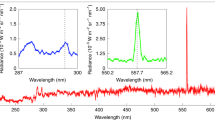Abstract
Almost 20 years after Nicolet1 suggested the presence of nitric oxide in the upper atmosphere as a source of D-region ionization by solar Lyman α-radiation, this trace species was first observed2 by the resonance fluorescence method; almost 10 years later, its vertical distribution was observed in the stratosphere by means of balloon-borne infrared absorption spectrometry3. Since then much emphasis has been placed on odd nitrogen compounds in the stratosphere, partly because of their role in controlling the ozone abundance. Many measurements have been made of NO, NO2, HNO3 and NO3 in the stratosphere with inferences on the N2O5 abundance. Meanwhile, several determinations of NO in the mesosphere and in the lower thermosphere4–10 have used resonance fluorescence and mass spectrometry11. We report here the first observation of NO from the low thermosphere down to the low stratosphere by instrumentation similar to that used previously on board balloon gondolas, but on this occasion the observation platform was Spacelab I, which gave access to higher altitudes. As before12, NO and NO2 were observed simultaneously.
This is a preview of subscription content, access via your institution
Access options
Subscribe to this journal
Receive 51 print issues and online access
$199.00 per year
only $3.90 per issue
Buy this article
- Purchase on Springer Link
- Instant access to full article PDF
Prices may be subject to local taxes which are calculated during checkout
Similar content being viewed by others
References
Nicolet, M. Mem. Inst. R. Met. Belg. 19, 1–143 (1945).
Barth, C. A. J. Geophys. Res. 69, 3301–3303 (1964).
Ackerman, M. et al. Nature 245, 205–206 (1973).
Meira, L. G. J. geophys. Res. 76, 202–212 (1971).
Tisone, G. C. J. geophys. Res. 78, 746–750 (1973).
Witt, G., Dye, J. E. & Wilhelm, N. J. atmos. terr. Phys. 38, 233–238 (1976).
Tohmatsu, T. & Iwagami, N. Space Res. 15, 241 (1975).
Baker, K. D. et al. J. Geophys. Res. 82, 3301–3303 (1964).
Thomas, R. J. J. geophys. Res. 83, 513–516 (1978).
Massie, S. T. J. geophys. Res. 85, 2155–2164 (1980).
Trinks, H., von Zahn, U., Barth, C. A. & Kelly, K. K. J. geophys. Res. 83, 203–206 (1978).
Ackerman, M. et al. Planet. Space Sci. 23, 651–660 (1975).
Lemaitre, M.-P. et al. Science 225, 171–172 (1984).
Rothman, L. S. et al. Appl. Opt. 22, 2247 (1983).
Author information
Authors and Affiliations
Rights and permissions
About this article
Cite this article
Laurent, J., Lemaitre, MP., Besson, J. et al. Middle atmospheric NO and NO2 observed by the Spacelab grille spectrometer. Nature 315, 126–127 (1985). https://doi.org/10.1038/315126a0
Received:
Accepted:
Issue Date:
DOI: https://doi.org/10.1038/315126a0
This article is cited by
-
Nitric oxide density measurements at middle latitudes
Studia Geophysica et Geodaetica (1990)
-
Intercomparison of NO column measurements during MAP/GLOBUS 1985
Journal of Atmospheric Chemistry (1988)
Comments
By submitting a comment you agree to abide by our Terms and Community Guidelines. If you find something abusive or that does not comply with our terms or guidelines please flag it as inappropriate.



